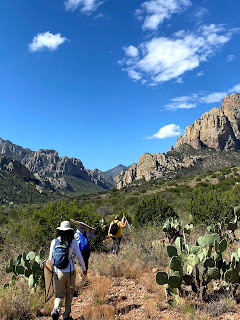¡Buenas Dias, Arivaca !
Before arriving here, I joked that the name Arivaca might be short for arid vaca (cow, in Spanish). While this Southeastern Arizona town is indeed ranch country, the name, I've just learned, courtesy of the Visit Arivaca site, has native roots:
The O'odham (Pima and Tonono) Indians, possibly descendants of
the Hohokam, occupied the valley for many years, and named the
area; "Ari" (Ali) means "little," "vaca" (wahia) refers to a place
where water comes up.
Lake Arivaca is nearby, but there are plenty of refreshing discoveries and food for thought right here at Pandora Ranch, where our second and final mobile research station is abuzz. Tasks include photographing caterpillars, "zoo-ing" them (removing frass and feeding them), organizing host plants to make sure caterpillars have what to munch on, and recording recording caterpillars' life history stages, which include:
- instar, a very young caterpillar that has molted once or twice
- caterpillar
- pupa
- lepidoptera (moths and butterflies)
from
Caterpillars of Eastern North America: A Guide to Identification and Natural History by David L. Wagner, Princeton University Press, 2005.
We started the day with a presentation by soon-to-be PhD,
Danielle Salcido, (Dani), whose excitement about caterpillar research is full-bodied and contagious. Her talk focused on long-term trends in the diversity of interactions between caterpillars and parasitoids at research sites in Costa Rica and Ecuador. The data we are gathering here in Arizona will be used to examine trends here.
This immersion in science brings with it, for me, new concepts, new ways of thinking and new vocabulary. During the school year, I'm a teacher of English as a New Language. For now, I am learning Science as a new language, gathering words, approximating their meanings and jotting down tentative spellings. Today's word was
speciose, rich in variety of species. Beetles are the most speciose genus; caterpillars are the second most speciose. Impressive.
Our experiences here are varied and resonate on many levels. Following Dani's talk, we segued to a conversation about how to introduce scientific findings to students, with a reich array of approaches and resources, including:
After lunch, more lab work, and then another standout activity, ably facilitated by our senior fellow Gina, who led brainstorming sessions which helped us lay the groundwork for our individual Community Action Plans/ lesson plans.
So far, it looks like our caterpillar fieldwork is helping to spawn action projects related to climate change, science careers, stewardship of public parks, deep dives into data and programs on native peoples and native plants.





Comments
Post a Comment